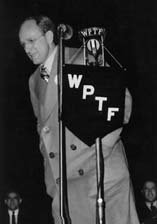|
Going Back to "Kollege"
"There
was a lot of radio air time from the Blackhawk, and what we
didn’t know was that the college kids … were
listening and thought we were great," Kyser recalled. "When
they came home for the holidays, the Blackhawk turned out to
be the hardest tickets in town, and we were on our way." The
"Kollege" became a roaring success in Chicago and continued
to be broadcast locally. In 1938 the American Tobacco
Company bought the show for Lucky Strike. Airing weekly on
NBC, the "Kollege" went nationwide. Kyser – who had
been dubbed the "Genius of Jazz" by the New York Times
– became famous.
"The
‘Kollege’ was always clean and wholesome,
something the whole family would share," Chapel Hill
Newspaper Editor Orville Campbell,
a Kyser family friend, wrote in 1983. Each
week, 20 million listeners tuned in to hear Kyser’s
signature greeting: "Evenin’ folks, how y’all?"
They laughed at Ish Kabibble, the sincere but not-so-smart
"stoodent" of the Kollege. Audience members tried to win $35
and a diploma by answering questions: "Mrs. Filbert, the
opera Aida is located on the River Nile. Mrs. Edgar
Greenbower of Ames, Iowa, wants to know what country the
Nile flows through… Albania?… That’s right,
you’re wrong!" By
1939, Kyser’s records were best-sellers; by 1940, he
began appearing on the big screen. The band starred in seven
full-length Hollywood films and appeared in several movie
shorts, and was often described as the most lucrative in the
history of show business. Time magazine called Kyser the
biggest moneymaker in his field in 1941. He grossed more
than $1 million that year.
| |||||
|
| |||||
|
©1998 All Rights Reserved Feedback | Credits | |||||


